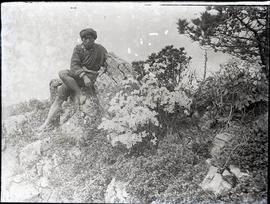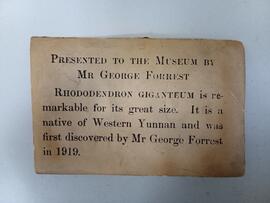FRG/1 Correspondence
• 1: Box of Forrest correspondence, 1903-08 (to and from Clementina, I.B. Balfour, Bulley, Family), Forrest related correspondence, copies of his birth and marriage certificates, transcripts of his diary 1904-05, ‘Account of a Journey on the Upper Salwin, October to December 1905’, copy of the article ‘Land of the Crossbow, March 9th 1906’ from the National Geographic Magazine, (carbon copy, original version is in the red notebook under letter 3, filed in
the same box)
• 2: Box of Forrest correspondence, 1909-1911 – correspondence regarding his Yunnan expedition in 1910, and with I.B. Balfour and correspondence relating to Forrest.
• 3a: Box of Forrest correspondence with J.C. Williams 1911-1912, regarding his third expedition (February 1912-March 1915)
• 3b: Box of Forrest correspondence with J.C. Williams and I.B. Balfour, 1913-14 regarding his third expedition (February 1912- March 1915)
• 3c: Box of Forrest correspondence from 1915 regarding his third expedition (February 1912- March 1915)
• 4a: Box of Forrest correspondence from 1917-1920 regarding his fourth expedition (February 1917-March 1920)
• 4b: Box of Forrest correspondence, including I.B. Balfour and William Wright Smith, 1916-1920, regarding his fourth expedition (February 1917-March 1920)
• 5: Box of Forrest correspondence from June 1920-April 1923 regarding his fifth expedition (January 1921-March 1923)
• 6: Box of Forrest correspondence from 1922-28
• 7: Box of Forrest correspondence from 1929-1932, plus obituaries, etc.
FRG/2 Photographs
FRG/2/1 Prints:
• File of photographs marked ‘Forrest, Collectors, Human, etc.’
• File of photographs marked ‘Buildings, Temple, Graves, Towns, etc.’
• File of photographs marked ‘Mountain, Water, Bridge’
• File of photographs marked ‘Plants A-L’
• File of photographs marked ‘Plants M-Prim-’
• File of photographs marked ‘Plants Py-Z and misc.’
FRG/2/2 Glass Plate Negative Collection
FRG/3 Published work
• copy of the article ‘Land of the Crossbow’, from the National Geographic Magazine
FRG/4 Field Books
FRG/4/1 Unpublished Field Books:
• George Forrest’s field books – 27 original field books dating from 1904 to 1932
FRG/4/2 Published Field Books:
FRG/5 RBGE’s Notes relating to Forrest’s plants
• 16 folders in 15 boxes of RBGE’s plant collection notes arranged alphabetically by genus
• Three boxes of Rhododendron notes written and sent by Isaac Bayley Balfour and William Wright Smith c.1919,1921 and 1922 and Primula lists c.1914,1921 and 1922
FRG/6 Forrest’s lecture notes
• Box of lecture notes and lists of slides
• Box containing photo related lists, 1913-24 and lecture notes
FRG/7 Forrest’s collection of papers (unsorted at present)
FRG/8 maps
• Various maps of Forrest’s Botanical expeditions
• File containing maps from 1918-1922, some annotated and some hand drawn
FRG/9 - collection of work about Forrest by others, includes
• Box containing Cowan’s research from 1934 and information regarding Forrest Centenary in 1973
• Various articles referring to Forrest
• Various newspaper articles which mention George Forrest
FRG/10 RBGE Forrest ephemera – collection of objects used by / related to George Forrest
• Camera similar to one used by Forrest
Photocopy of letter sent by John Abercromby, Secretary of the Society of Antiquaries of Scotland to Isaac Bayley Balfour, dated 21 June 1903; Asks if Balfour knows of any person or society wanting a collector of botanical specimens abroad. Recommends ‘a young fellow of the name of Forrest’ who looks ‘the right sort of man.’
Copy letter from Isaac Bayley Balfour to George Forrest dated 03 September 1903 inviting Forrest to come to the Garden on 7 September. Assistant in the Herbarium will give him instructions as to work.
Copy letter from Isaac Bayley Balfour, RBGE,to Arthur Kilpin Bulley, Ness, Neston, Cheshire, dated 30 April 1904, in which Balfour states that 'Forrest should be all right in the way of health, honesty, steadiness, devotion to work, general knowledge of plants. Of his gardening powers I know nothing; he has not been on our gardening staff. I should say that if he knew what you want he would do well for you...’
Letter from J.W. Besant, Bees Ltd., Neston, Cheshire, to Isaac Bayley Balfour, RBGE, dated 02 October 1904, advising that they have forwarded several plants raised by them from seeds sent home by ‘our Mr Forrest’ and requesting assistance in identifying these.
RBGE Museum label used in the display of George Forrest's Rhododendron giganteum / Rhododendron protistum stating: 'Presented to the Museum by Mr George Forrest. Rhododendron Giganteum is remarkable for its great size. It is a native of Western Yunnan and was first discovered by Mr George Forrest in 1919.'
Zonder titelForman, Adam (1916 corres.)
•Papers and Correspondence re: Sphagnum Moss – Use as medical dressings (1st World War & 2nd World War references) - inc. W Wright Smith’s report to R.A.M.C. (War Dept.) dated 1916 are filed under “Sphagnum Moss as medical dressings” – index “S”
•11 copies of his obituary: Extracted from “Proceedings of The Linnean Society of London, Session 157, 1944-1945, Pt.2, 23 May 1946. Photograph: Lt-Col Andrew Thomas Gage, C.I.E. & pages105-109.
•Correspondence dated 1912-1913 on Primula filed with subject material under “Primula” (Box 1) in main index.
•Letter from D. Prain (Kew) dated 11 Dec 1909 to Major Gage re: max Sterculia filed under “Prain, D” in general index.
• Original transcript of George Gardner's "Brazilian plants, 1836-41". 3 copies of transcription made, 2 for J. A. Ratter (donor) & 1 to be bound for Library shelves RBGEA2006.08
Zonder titel•3 boxes of translations and correspondence between Rev. Henry Edward Fowler Garnsey and Isaac Bayley Balfour relating to Garnsey's translation of A.W. Eichler, including the m/s translation itself.
Zonder titel
